Energy Efficient Routing Algorithm with Mobile Sink Support for Wireless Sensor Networks
Abstract
:1. Introduction
2. Related Work
3. System Model
3.1. Basic Assumptions
- All sensors are randomly deployed by vehicles, such as a plane, and remain stationary after deployment.
- All sensors have the knowledge of the location of the other nodes via the information exchange.
- All sensors have the same initial energy and their batteries cannot be changed. Once a sensor exhausts its energy, it will be useless.
- The transmission power of sensors could be adjusted based on the communication distance.
- The moving trajectory of the mobile sink is well-scheduled and it owns unlimited energy and communication range.
3.2. Network Model
3.3. Energy Model
4. Our Proposed Routing Schema
4.1. Clustering Formation
4.2. CH Selection
4.3. Intracluster Communication
4.4. Intercluster Communication
4.5. Migration Strategy of the Mobile Sink
5. Performance Evaluation
5.1. Simulation Environment
5.2. Comparation of Different Algorithms
6. Network Parameters Adjustment and Performance Enhancement
6.1. Study of the Radius of the Moving Trajectory
6.2. Study of the Methods of Weight Calculation of CHs
6.3. Study of the Number of Clusters
6.4. Study of the Speed of the Mobile Sink
6.5. Study of Multiple Mobile Sinks
7. Discussions and Open Research Issues
7.1. Uneven Energy Distribution Between Clusters
- Sensors were deployed unevenly and each cluster could have different number of nodes.
- The average distance between nodes and the regional center in one cluster could be longer than that in other clusters.
7.2. Open Research Issues
8. Conclusions
Author Contributions
Funding
Conflicts of Interest
References
- Akyildiz, I.F.; Su, W.; Sankarasubramaniam, Y.; Cayirci, E. Wireless sensor networks: A survey. Comput. Netw. 2002, 38, 393–422. [Google Scholar] [CrossRef]
- Zeng, D.; Dai, Y.; Li, F.; Sherratt, R.S.; Wang, J. Adversarial learning for distant supervised relation extraction. Comput. Mater. Contin. 2018, 55, 121–136. [Google Scholar]
- Pan, J.S.; Kong, L.; Sung, T.W.; Tsai, P.W.; Snasel, W. α-Fraction First Strategy for Hirarchical Wireless Sensor Neteorks. J. Internet Technol. 2018, 19, 1717–1726. [Google Scholar]
- Chanak, P.; Indrajit Banerjee, I.; Wang, J.; Sherratt, R.S. Obstacle Avoidance Routing Scheme through Optimal Sink Movement for Home Monitoring and Mobile Robotic Consumer Devices. IEEE Trans. Consum. Electron. 2014, 60, 23–29. [Google Scholar] [CrossRef]
- Wang, J.; Zhang, Z.; Li, B.; Lee, S.; Sherratt, R.S. An Enhanced Fall Detection System for Elderly Person Monitoring using Consumer Home Networks. IEEE Trans. Consum. Electron. 2014, 60, 23–29. [Google Scholar] [CrossRef]
- Al-Karaki, J.N.; Kamal, A.E. Routing techniques in wireless sensor networks: A survey. IEEE Wirel. Commun. 2004, 11, 6–28. [Google Scholar] [CrossRef]
- Yin, C.; Xi, J.; Sun, R.; Wang, J. Location privacy protection based on differential privacy strategy for big data in industrial internet of things. IEEE Trans. Ind. Inform. 2018, 14, 3628–3636. [Google Scholar] [CrossRef]
- Wang, J.; Gao, Y.; Yin, X.; Li, F.; Kim, H. An Enhanced PEGASIS Algorithm with Mobile Sink Support for Wireless Sensor Networks. Wirel. Commun. Mob. Comput. 2018, 2018, 9472075. [Google Scholar] [CrossRef]
- Yao, J.; Zhang, K.; Yang, Y.; Wang, J. Emergency vehicle route oriented signal coordinated control model with two-level programming. Soft Comput. 2018, 22, 4283–4294. [Google Scholar] [CrossRef]
- Ren, Y.; Liu, Y.; Ji, S.; Sangaiah, A.K.; Wang, J. Incentive Mechanism of Data Storage Based on Blockchain for Wireless Sensor Networks. Mob. Inf. Syst. 2018. [Google Scholar] [CrossRef]
- Li, X.; Yang, J.L.; Nayak, A.; Stojmenovic, I. Localized geographic routing to a mobile sink with guaranteed delivery in sensor networks. IEEE J. Sel. Area Commun. 2012, 30, 1719–1729. [Google Scholar] [CrossRef]
- Wang, J.; Yang, X.; Li, B.; Lee, S.Y.; Jeon, S. A mobile sink based uneven clustering algorithm for wireless sensor networks. J. Internet Technol. 2013, 14, 895–902. [Google Scholar]
- Wang, J.; Cao, J.; Ji, S.; Park, J.H. Energy-efficient cluster-based dynamic routes adjustment approach for wireless sensor networks with mobile sinks. J. Supercomput. 2017, 73, 3277–3290. [Google Scholar] [CrossRef]
- Khan, A.W.; Abdullah, A.H.; Anisi, M.H.; Bangash, J.I. A Comprehensive Study of Data Collection Schemes Using Mobile Sinks in Wireless Sensor Networks. Sensors 2014, 14, 2510–2548. [Google Scholar] [CrossRef] [PubMed]
- Heinzelman, W.R.; Chandrakasan, A.; Balakrishnan, H. Energy-efficient communication protocol for wireless microsensor networks. Ad Hoc Sens. Wirel. Netw. 2000, 2. [Google Scholar] [CrossRef]
- Lindsey, S.; Raghavendra, C.S. PEGASIS: Power efficient gathering in sensor information systems. Proc. IEEE Aerosp. Conf. 2003, 3, 1125–1130. [Google Scholar]
- Younis, O.; Fahmy, S. HEED: A Hybrid, Energy-efficient, Distributed Clustering Approach for Ad hoc Sensor Networks. IEEE Trans. Mob. Comput. 2004, 3, 366–379. [Google Scholar] [CrossRef]
- Zhao, M.; Yang, Y.; Wang, C. Mobile Data Gathering with Load Balanced Clustering and Dual Data Uploading in Wireless Sensor Networks. IEEE Trans. Mob. Comput. 2015, 14, 770–785. [Google Scholar] [CrossRef]
- Zhu, C.; Wu, S.; Han, G.; Shu, L.; Wu, H. A Tree-Cluster-Based Data-Gathering Algorithm for Industrial WSNs With a Mobile Sink. IEEE Access. 2015, 3, 381–396. [Google Scholar] [CrossRef]
- Xie, G.; Pan, F. Cluster-Based Routing for the Mobile Sink in Wireless Sensor Networks with Obstacles. IEEE Access 2016, 4, 2019–2028. [Google Scholar] [CrossRef]
- Velmani, R.; Kaarthick, B. An efficient cluster-tree based data collection scheme for large mobile wireless sensor networks. IEEE Sens J. 2015, 15, 2377–2390. [Google Scholar] [CrossRef]
- Sasirekha, S.; Swamynathan, S. Cluster-chain mobile agent routing algorithm for efficient data aggregation in wireless sensor network. J. Commun. Netw. 2017, 19, 392–401. [Google Scholar]
- Wang, J.; Cao, Y.; Li, B.; Kim, H.J.; Lee, S. Particle Swarm Optimization based Clustering Algorithm with Mobile Sink for WSNs. Future Gener. Comput. Syst. 2017, 76, 452–457. [Google Scholar] [CrossRef]
- Wang, J.; Ju, C.; Gao, Y.; Sangaiah, A.K.; Kim, G. A PSO based Energy Efficient Coverage Control Algorithm for Wireless Sensor Networks. Comput. Mater. Contin. 2018, 56, 433–446. [Google Scholar]
- Wang, J.; Gao, Y.; Liu, W.; Sangaiah, A.K.; Kim, H.J. An Improved Routing Schema with Special Clustering using PSO Algorithm for Heterogeneous Wireless Sensor Network. Sensors 2019, 19, 671. [Google Scholar] [CrossRef] [PubMed]
- Abo-Zahhad, M.; Ahmed, S.M.; Sabor, N.; Sasaki, S. Mobile Sink-Based Adaptive Immune Energy Efficient Clustering Protocol for Improving the Lifetime and Stability Period of Wireless Sensor Networks. IEEE Sens. J. 2015, 15, 4576–4586. [Google Scholar] [CrossRef]
- Wang, J.; Cao, J.; Sherratt, R.S.; Park, J.H. An improved ant colony optimization-based approach with mobile sink for wireless sensor networks. J. Supercomput. 2018, 74, 6633–6645. [Google Scholar] [CrossRef]
- Tashtarian, F.; Hossein, Y.M.M.; Sohraby, K.; Effati, S. On maximizing the lifetime of wireless sensor networks in event-driven applications with mobile sinks. IEEE Trans. Veh. Technol. 2015, 64, 3177–3189. [Google Scholar] [CrossRef]
- Gao, Y.; Wang, J.; Wu, W.; Sangaiah, A.K.; Lim, S. A Hybrid Method for Mobile Agent Moving Trajectory Scheduling using ACO and PSO in WSNs. Sensors 2019, 19, 575. [Google Scholar] [CrossRef] [PubMed]
- Wang, J.; Zuo, L.; Shen, J.; Li, B.; Lee, S. Multiple mobile sink-based routing algorithm for data dissemination in wireless sensor networks. Concurr. Comput.-Pract. Exp. 2015, 27, 2656–2667. [Google Scholar] [CrossRef]
- Banerjee, T.; Agrawal, D.P. Increasing lifetime of wireless sensor networks using controllable mobile cluster heads. Wirel. Commun. Mob. Comput. 2010, 10, 313–336. [Google Scholar]
- Wang, J.; Gao, Y.; Liu, W.; Wu, W.; Lim, S. An Asynchronous Clustering and Mobile Data Gathering Schema based on Timer Mechanism in Wireless Sensor Networks. Comput. Mater. Contin. 2019, 58, 711–725. [Google Scholar]
- Lambrou, T.P.; Panayiotou, C.G. A survey on routing technique supporting mobility in sensor networks. In Proceedings of the 5th International Conference on Mobile Ad-Hoc and Sensor Networks, Fujian, China, 14–16 December 2009; pp. 78–85. [Google Scholar]
- Vukasinovic, I.; Babovic, Z.; Rakocevic, G. A survey on the use of mobile agents in wireless sensor networks. In Proceedings of the IEEE Conference on Industrial Technology, Athens, Greece, 19–21 March 2012; pp. 271–277. [Google Scholar]
- Luo, H.; Ye, F.; Cheng, J.; Lu, S.; Zhang, L. TTDD: Two-tier data dissemination in large-scale wireless sensor networks. Wirel. Netw. 2005, 11, 161–175. [Google Scholar] [CrossRef]
- Zhou, Y.; Fang, Y.; Zhang, Y. Securing wireless sensor networks: A survey. IEEE Commun. Surv. Tutor. 2008, 10, 6–28. [Google Scholar] [CrossRef]
- Díaz-Sánchez, D.; Sherratt, R.S.; Almenarez, F.; Arias, P.; Marín, A. Secure store and forward proxy for dynamic IoT applications over M2M networks. IEEE Trans. Consum. Electron. 2017, 62, 389–397. [Google Scholar] [CrossRef]
- Rasheed, A.; Mahapatra, R.N. The three-tier security scheme in wireless sensor networks with mobile sinks. IEEE Trans. Parallel Distrib. Syst. 2012, 23, 958–965. [Google Scholar] [CrossRef]
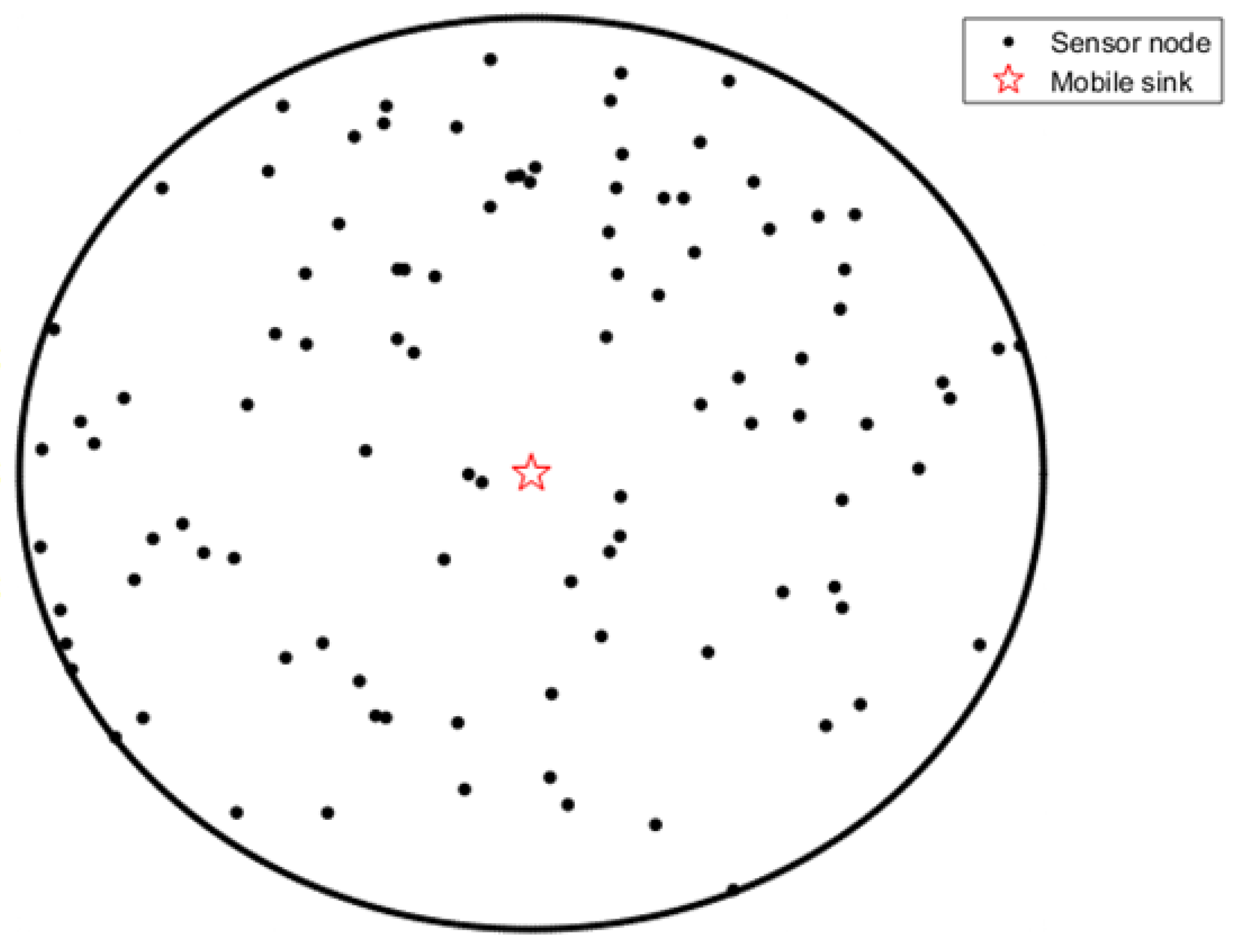

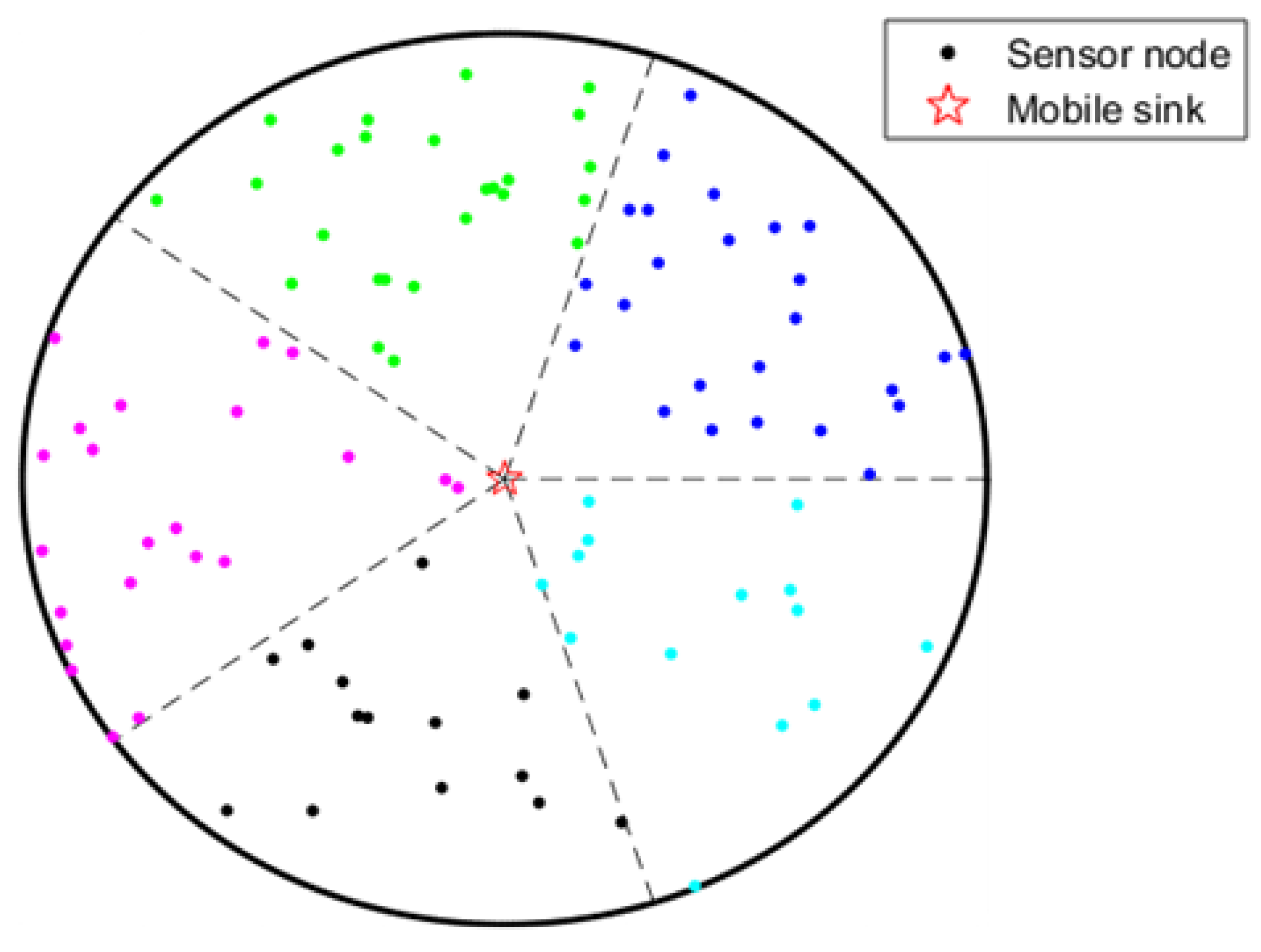
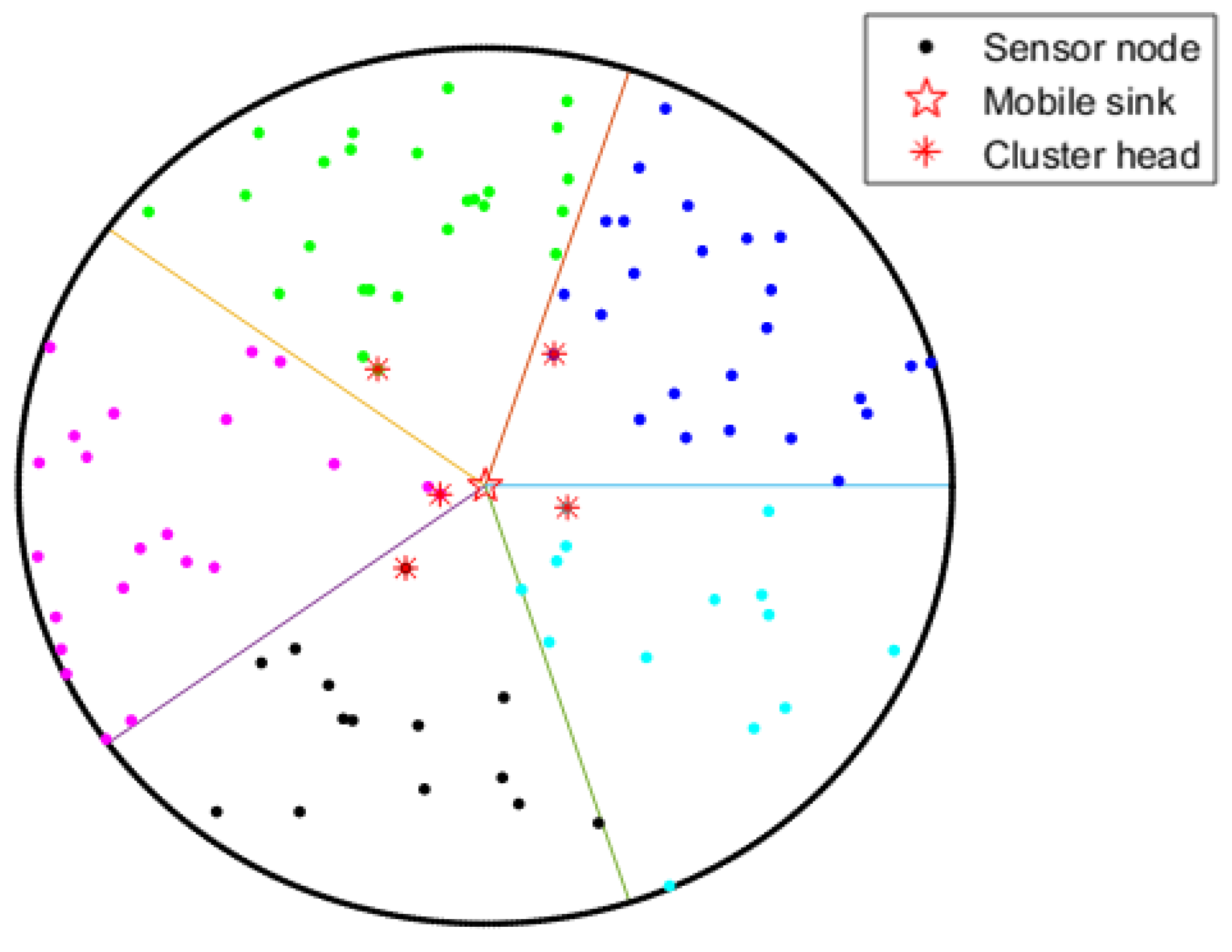
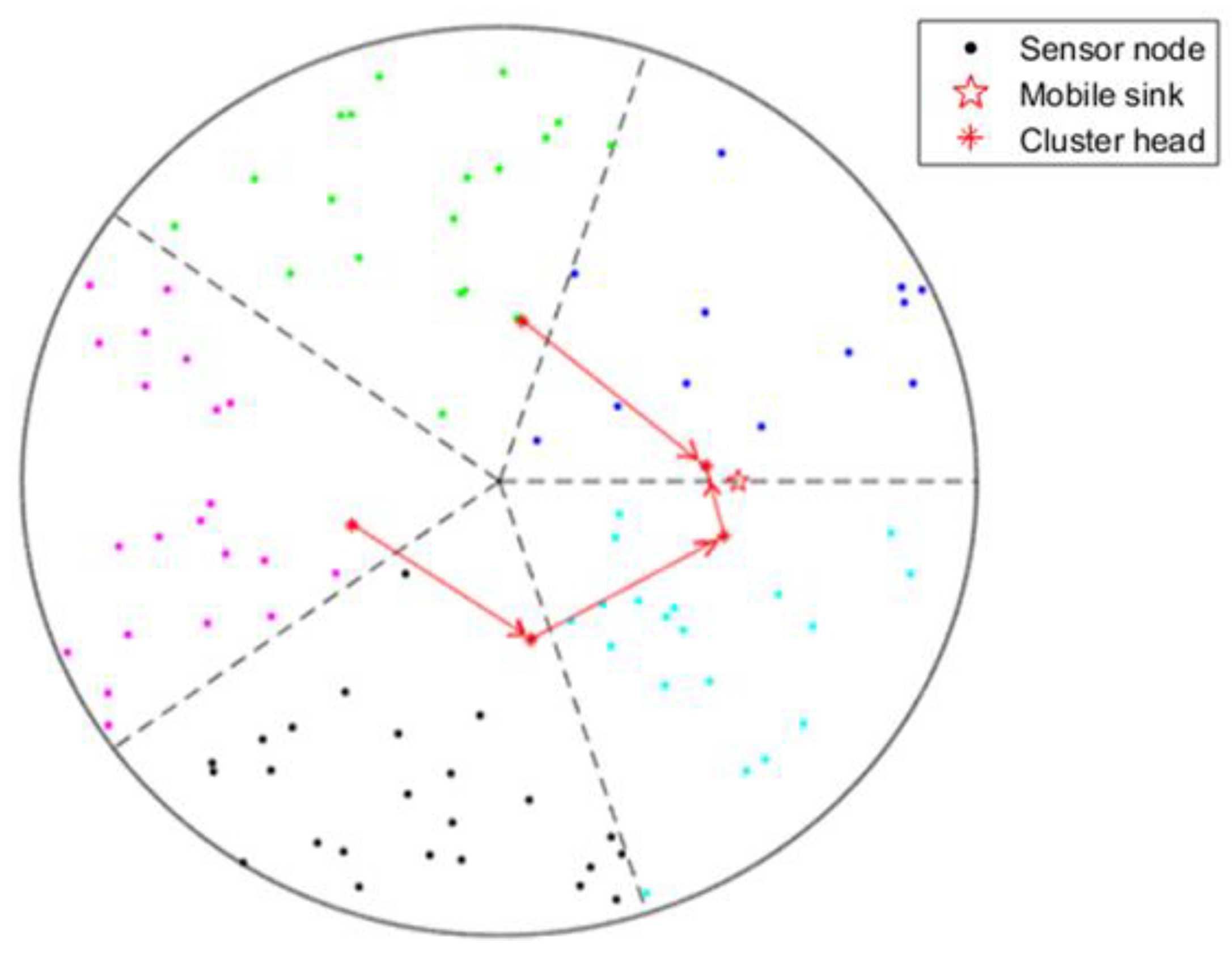
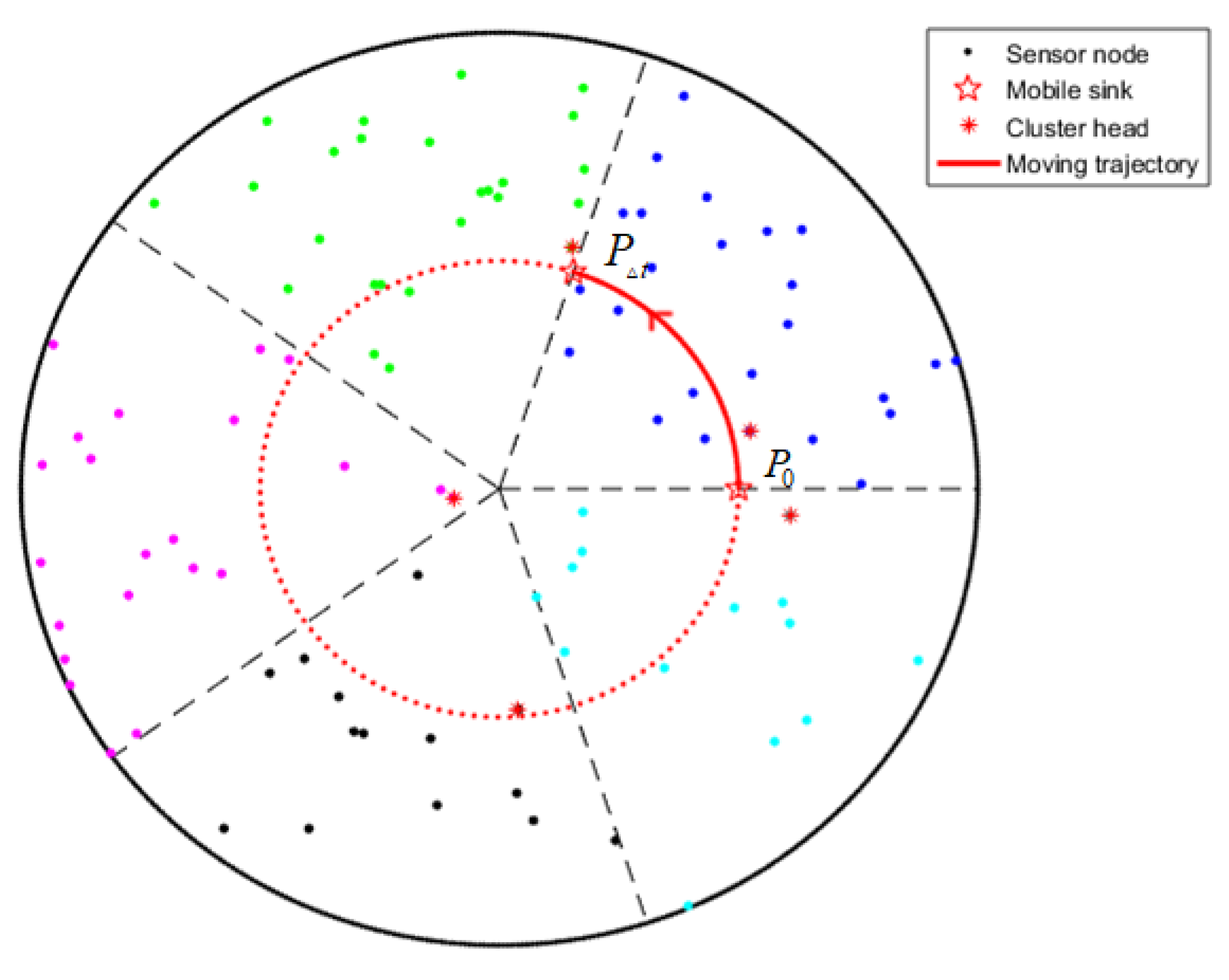
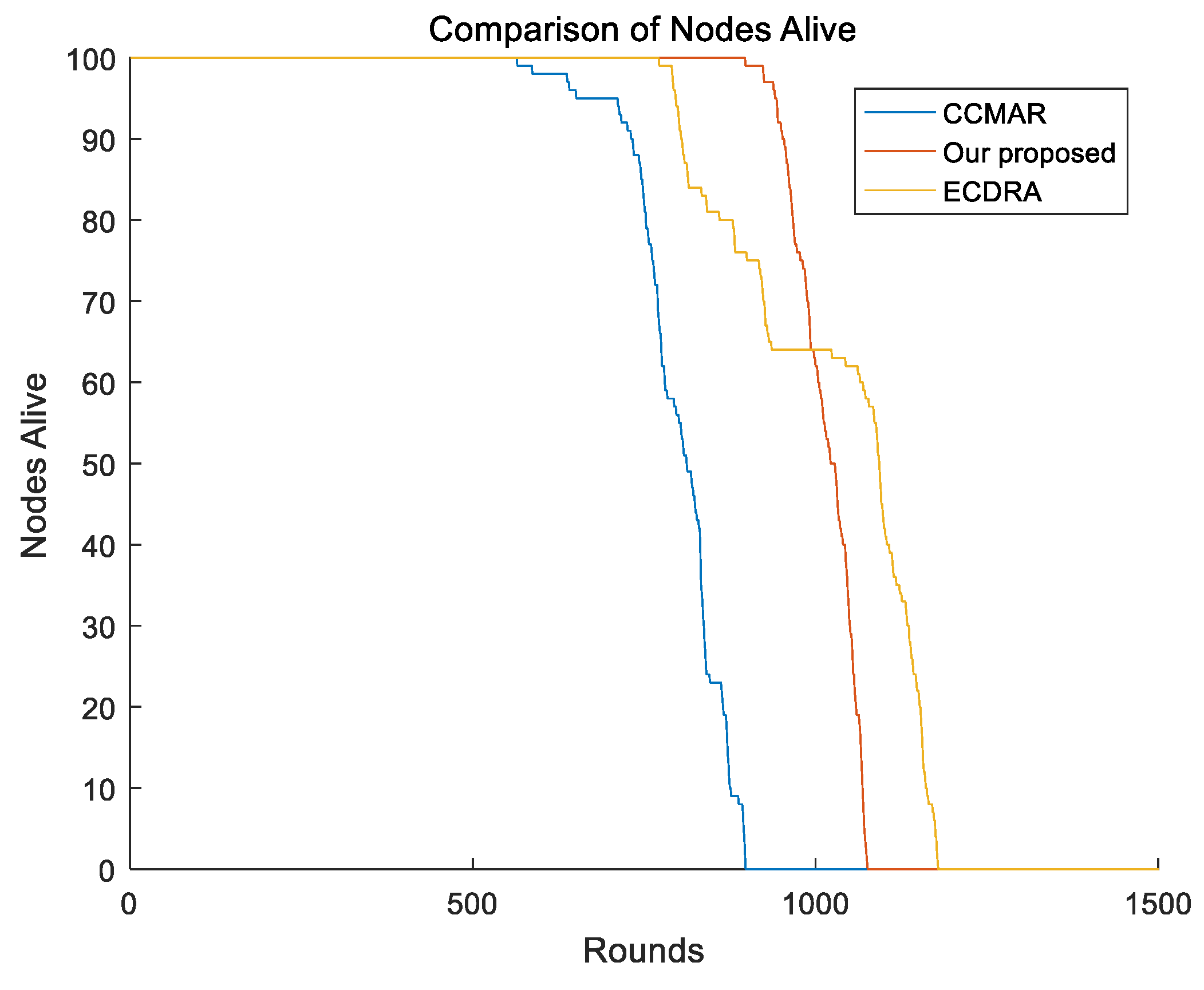
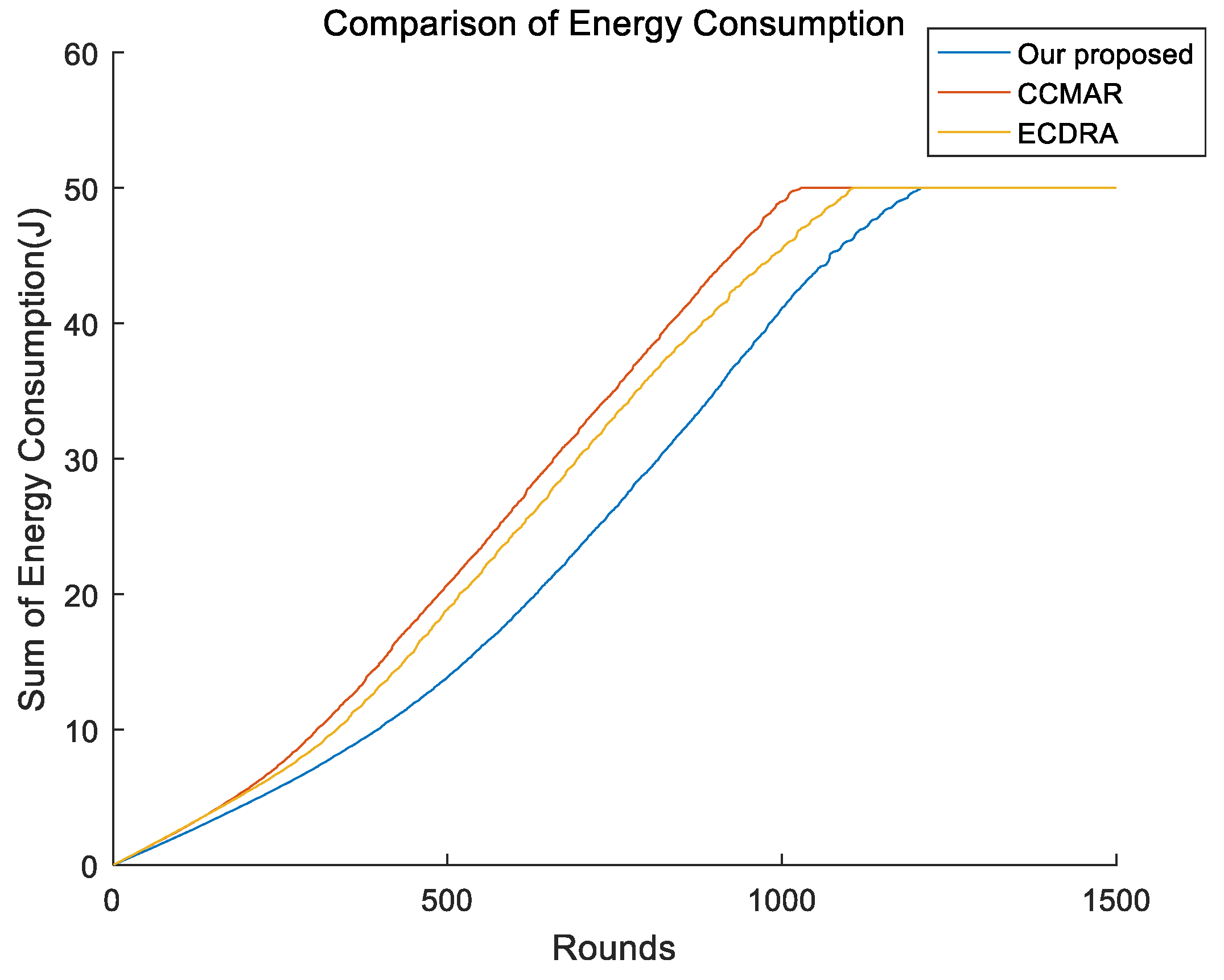
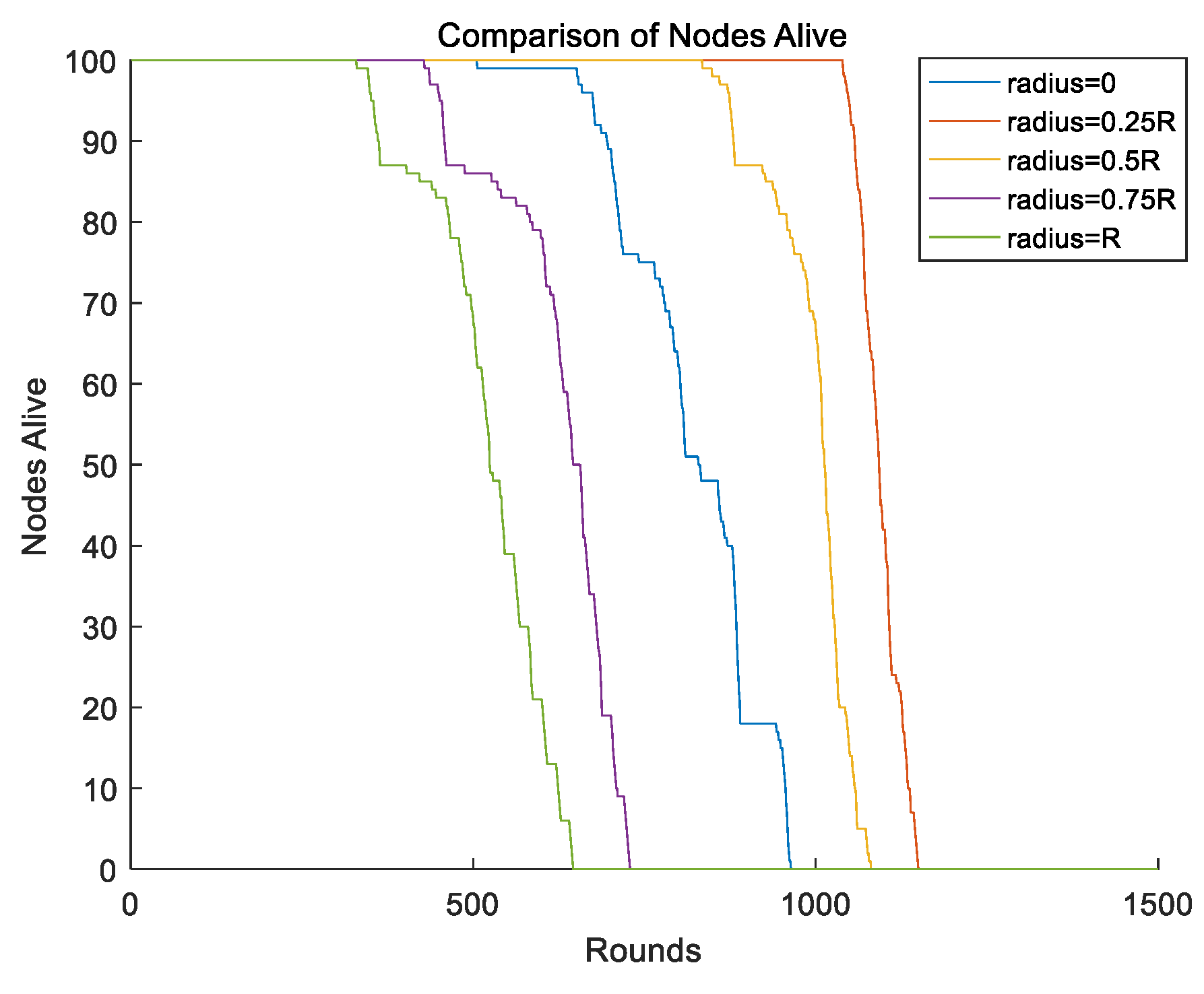
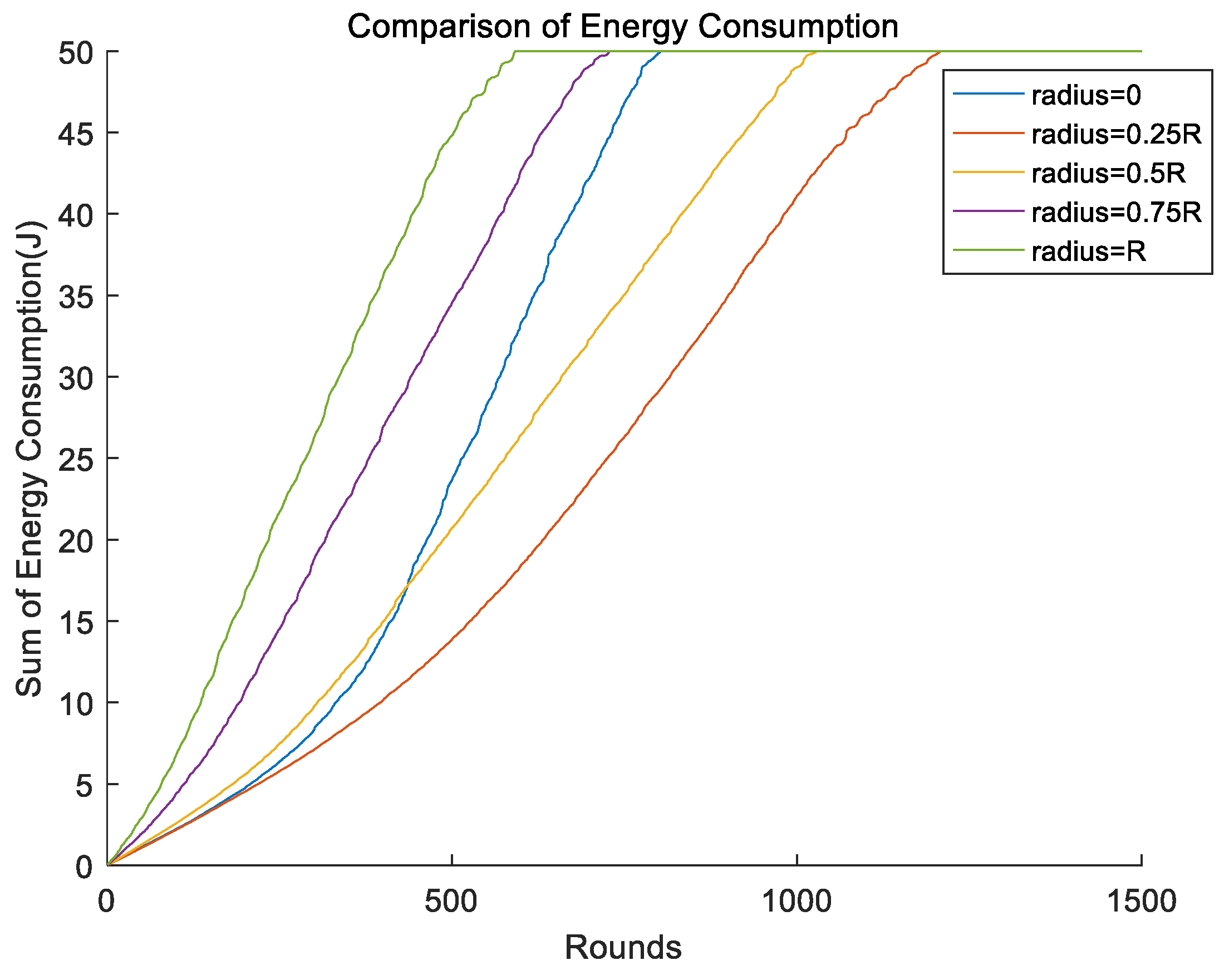
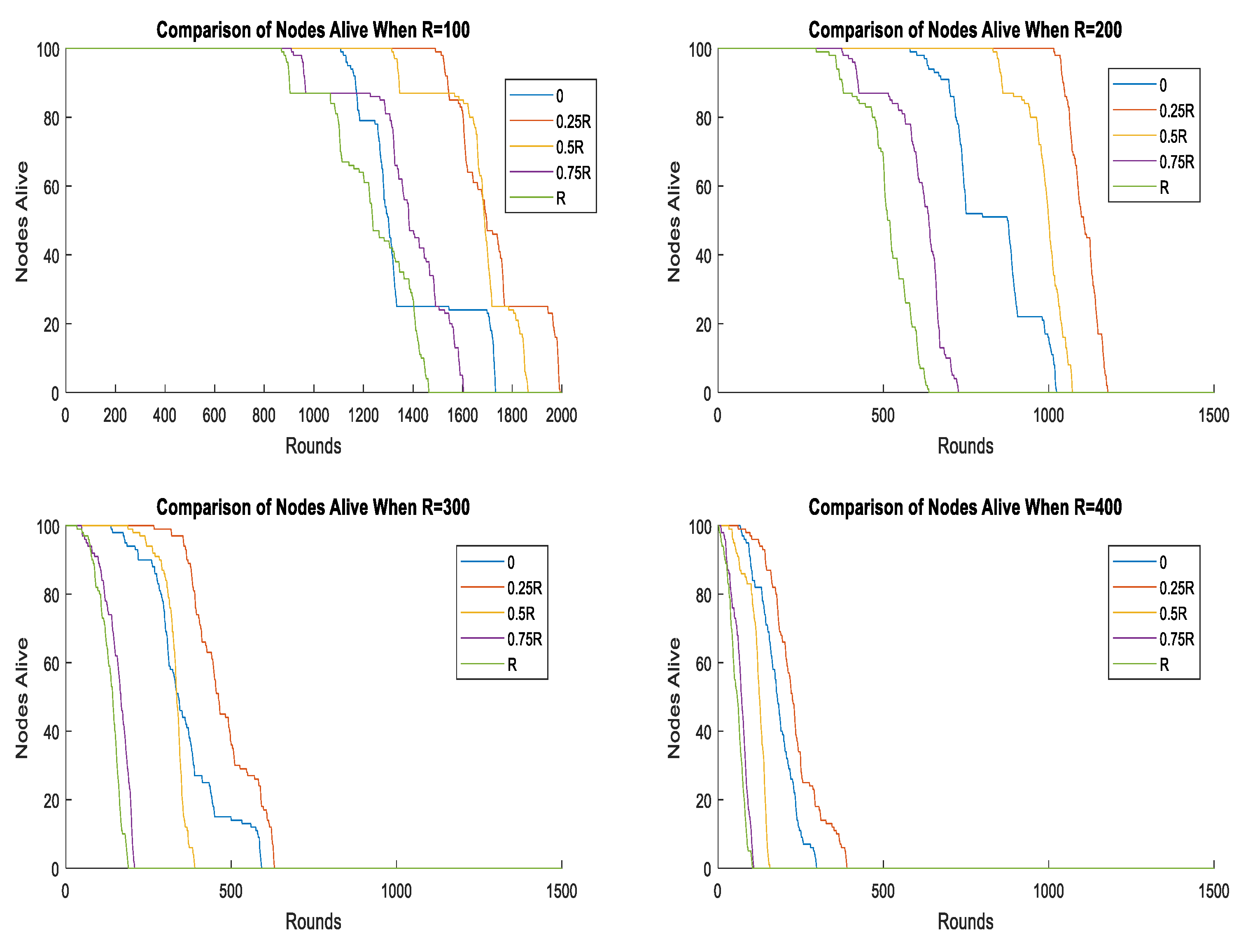
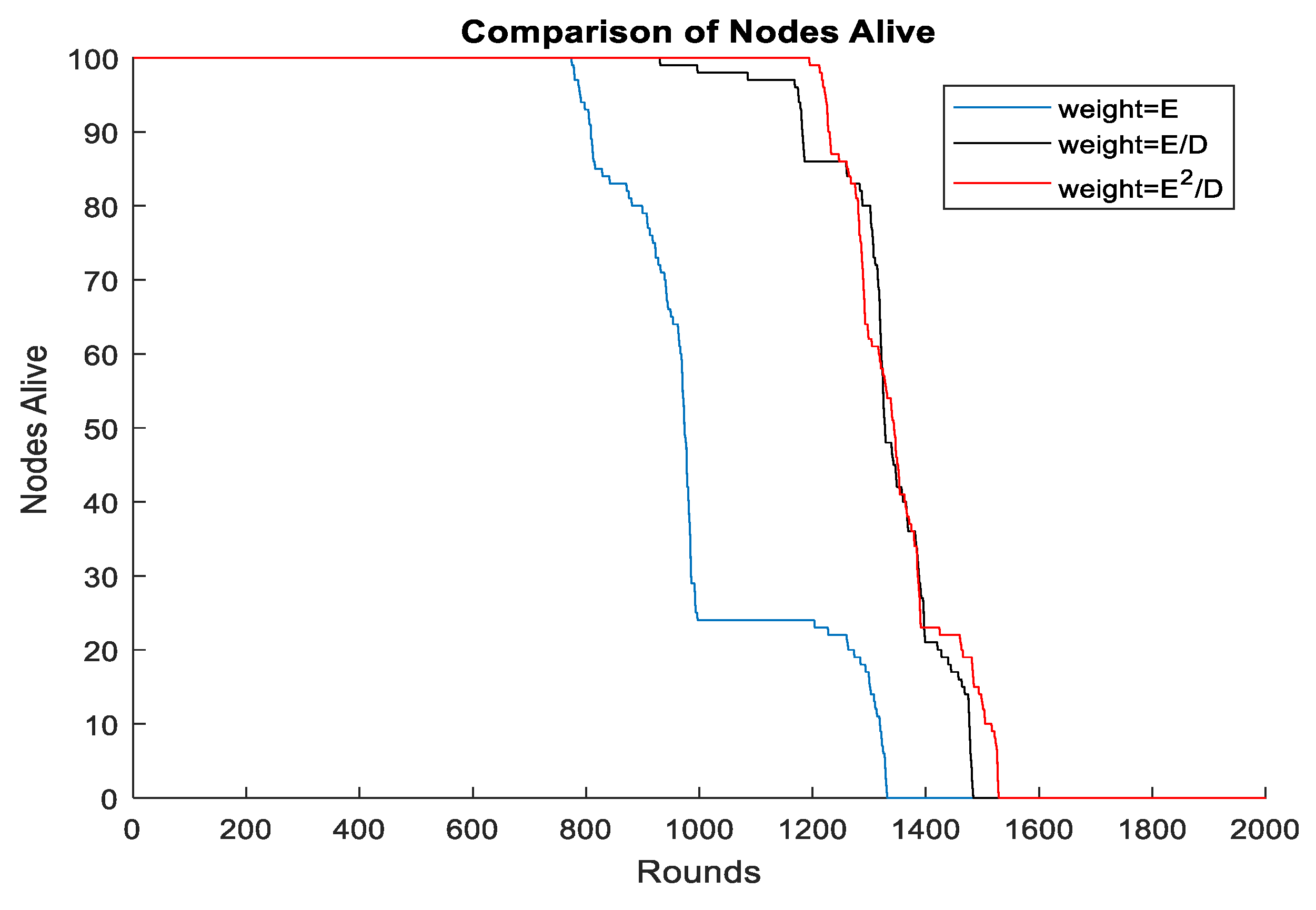
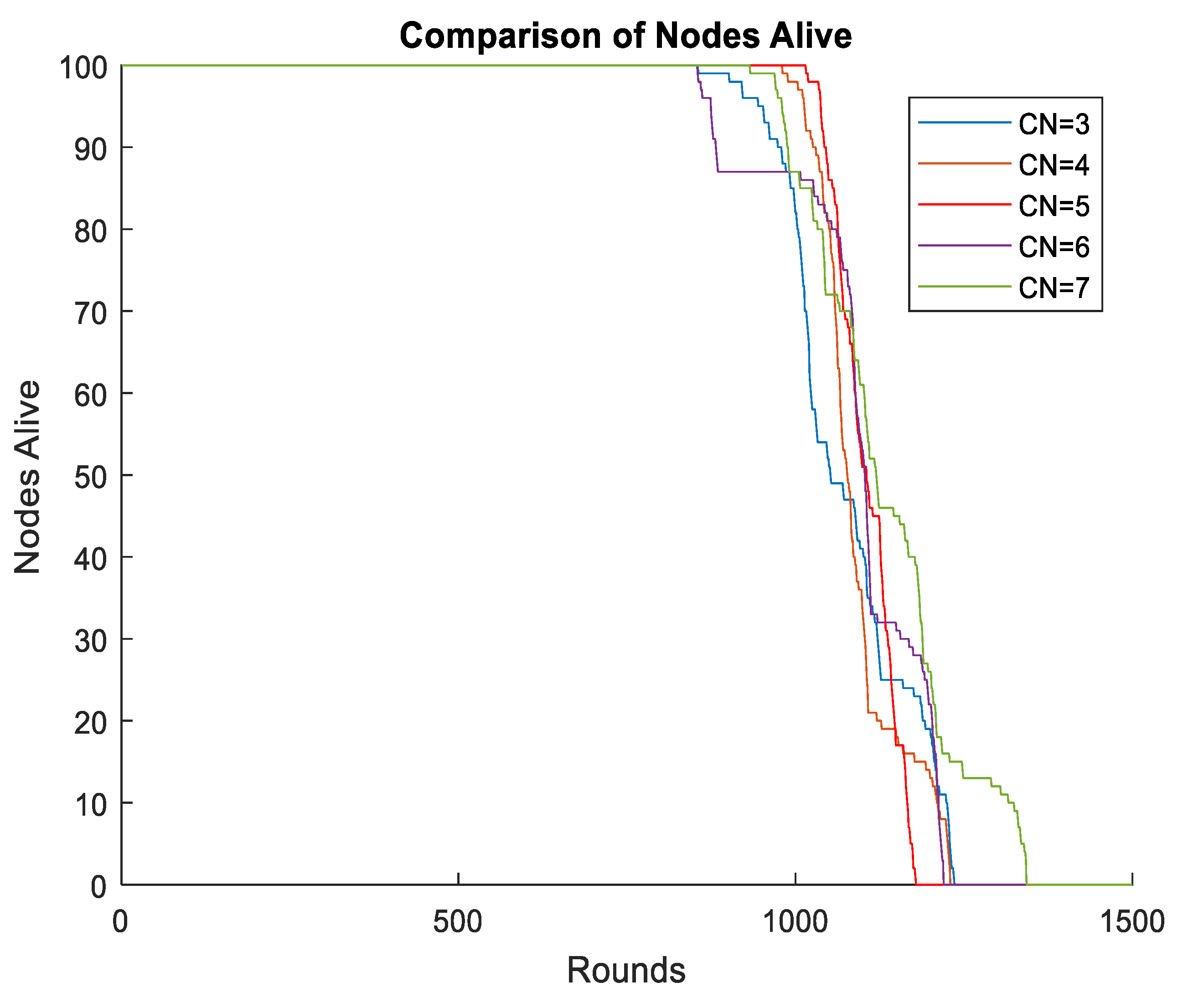
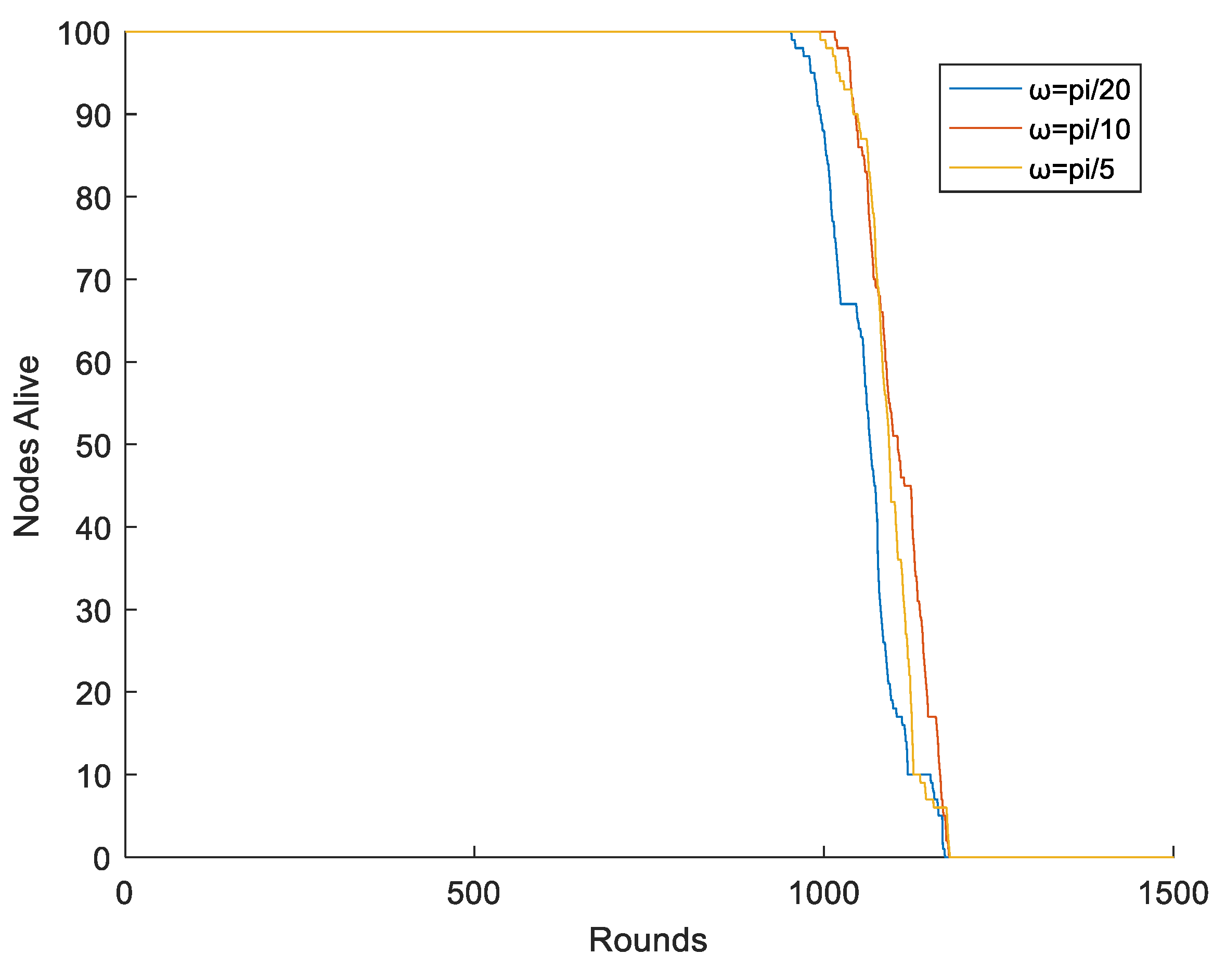
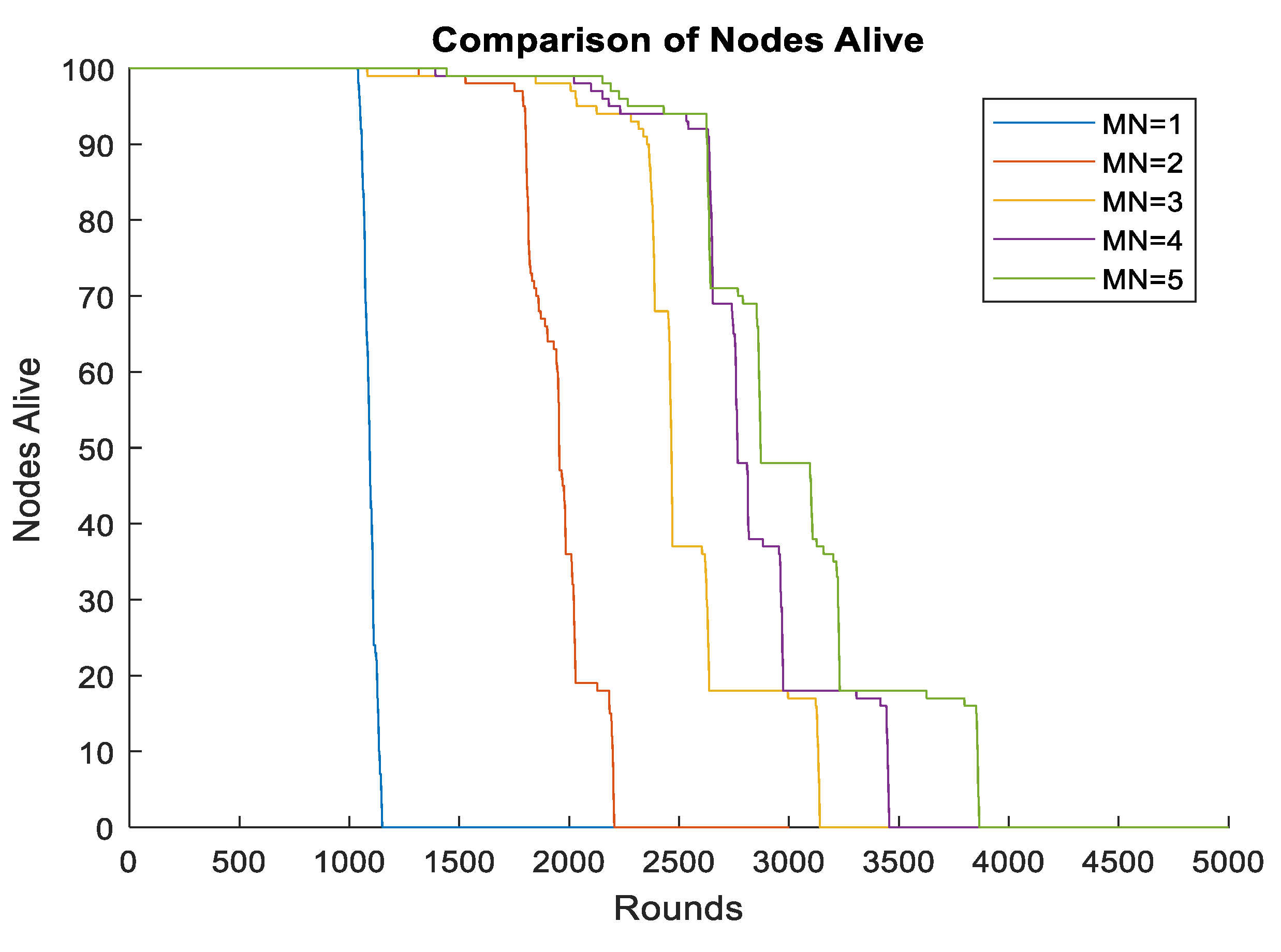
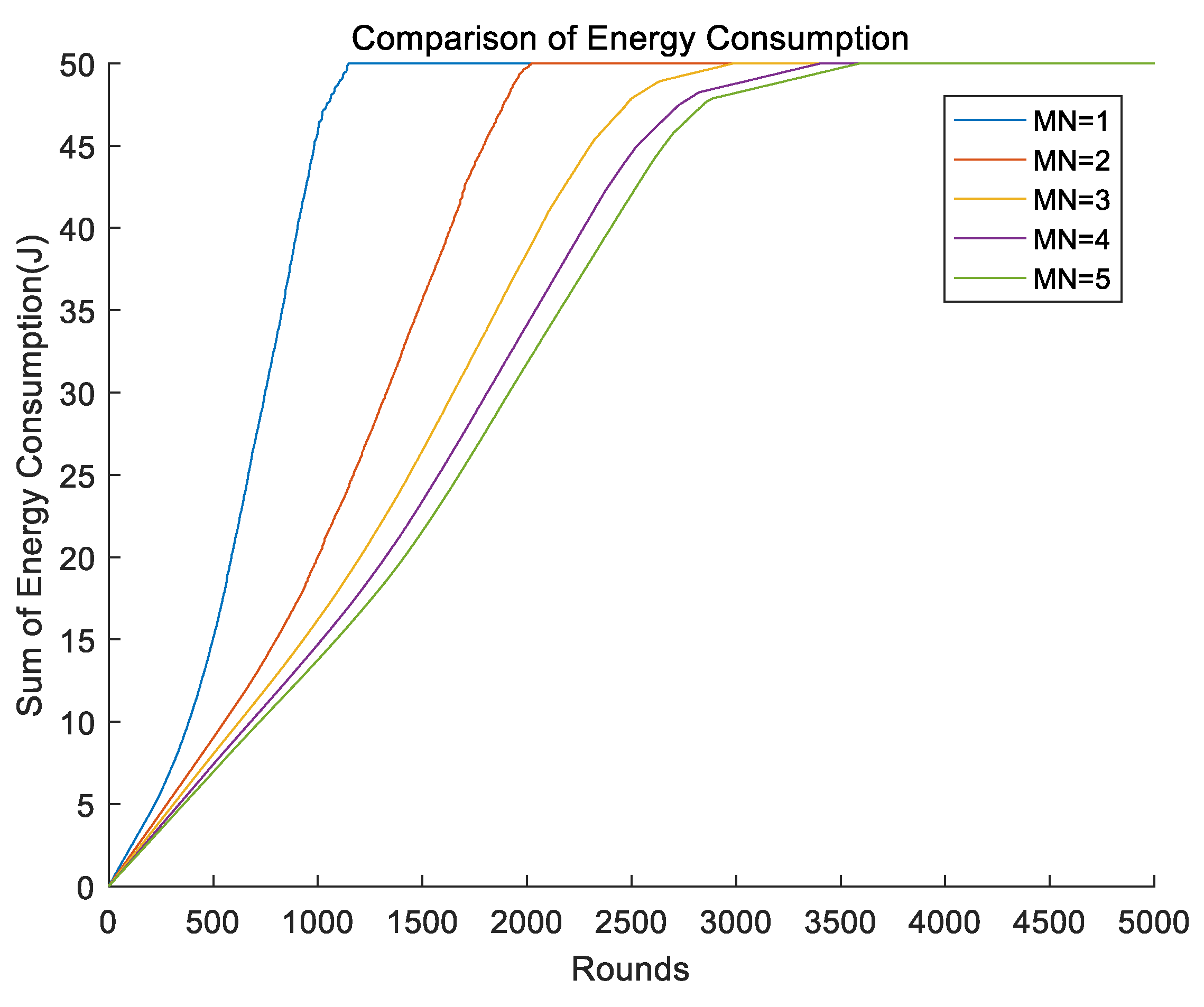
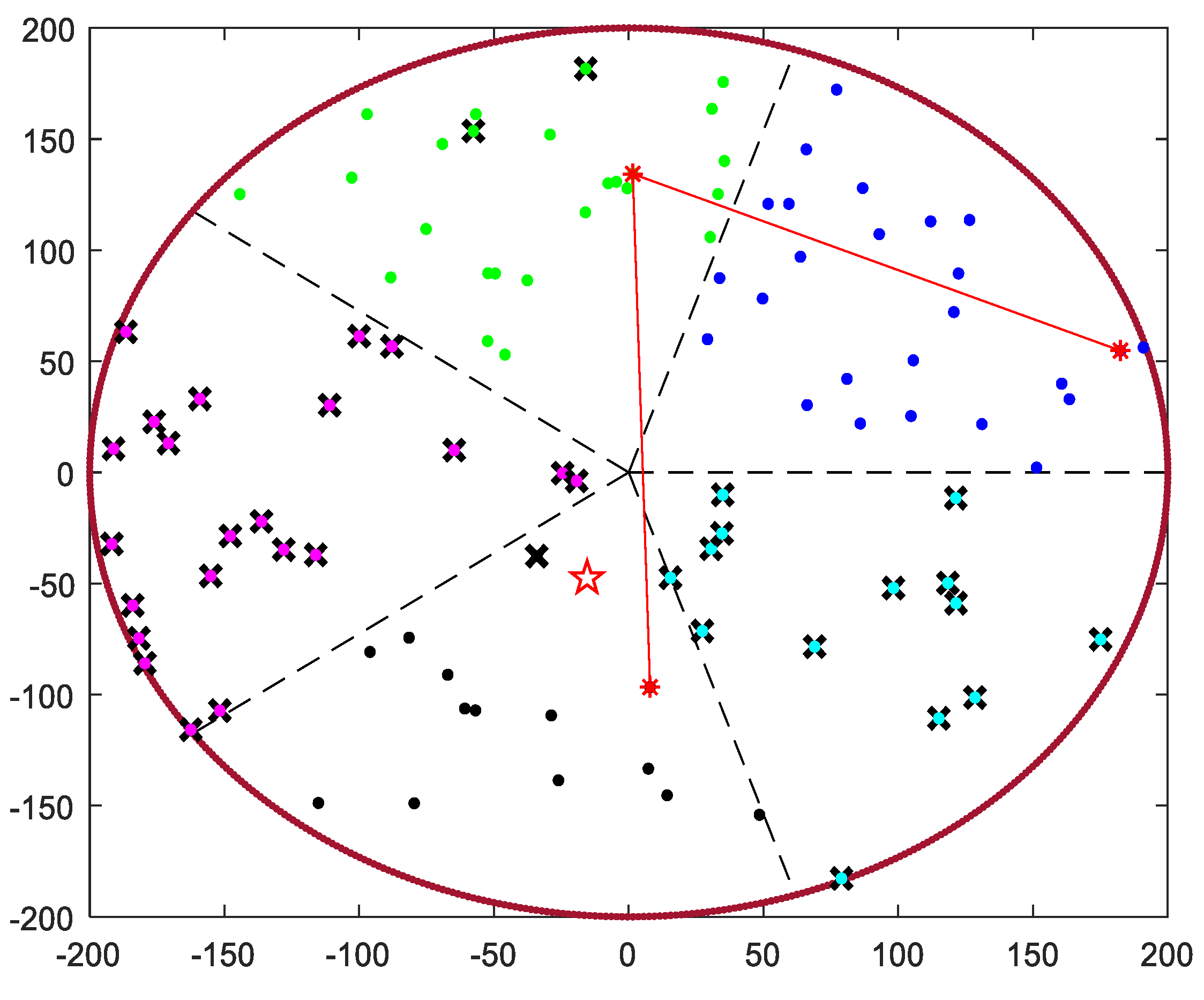
| Parameter Name | Value |
|---|---|
| Network radius (R) | [100, 200, 300, 400] m |
| Mobile sink radius (r) | [0, 0.25R, 0.5R, 0.75R, R] |
| Mobile sink number (MN) | [1, 2, 3, 4, 5] |
| Mobile sink speed (w) | [π/20, π/10, π/5] |
| Cluster number (CN) | [3, 4, 5, 6, 7] |
| Number of nodes (N) | 100 |
| Packet length (l) | 500 bits |
| Initial energy () | 0.5 J |
| Energy consumption on circuit () | 50 nJ/bit |
| Free-space model parameter () | 10 pJ/bit/m2 |
| Multi-path model parameter () | 0.0013 pJ/bit/m4 |
| Distance threshold () | m |
© 2019 by the authors. Licensee MDPI, Basel, Switzerland. This article is an open access article distributed under the terms and conditions of the Creative Commons Attribution (CC BY) license (http://creativecommons.org/licenses/by/4.0/).
Share and Cite
Wang, J.; Gao, Y.; Liu, W.; Sangaiah, A.K.; Kim, H.-J. Energy Efficient Routing Algorithm with Mobile Sink Support for Wireless Sensor Networks. Sensors 2019, 19, 1494. https://doi.org/10.3390/s19071494
Wang J, Gao Y, Liu W, Sangaiah AK, Kim H-J. Energy Efficient Routing Algorithm with Mobile Sink Support for Wireless Sensor Networks. Sensors. 2019; 19(7):1494. https://doi.org/10.3390/s19071494
Chicago/Turabian StyleWang, Jin, Yu Gao, Wei Liu, Arun Kumar Sangaiah, and Hye-Jin Kim. 2019. "Energy Efficient Routing Algorithm with Mobile Sink Support for Wireless Sensor Networks" Sensors 19, no. 7: 1494. https://doi.org/10.3390/s19071494
APA StyleWang, J., Gao, Y., Liu, W., Sangaiah, A. K., & Kim, H.-J. (2019). Energy Efficient Routing Algorithm with Mobile Sink Support for Wireless Sensor Networks. Sensors, 19(7), 1494. https://doi.org/10.3390/s19071494






